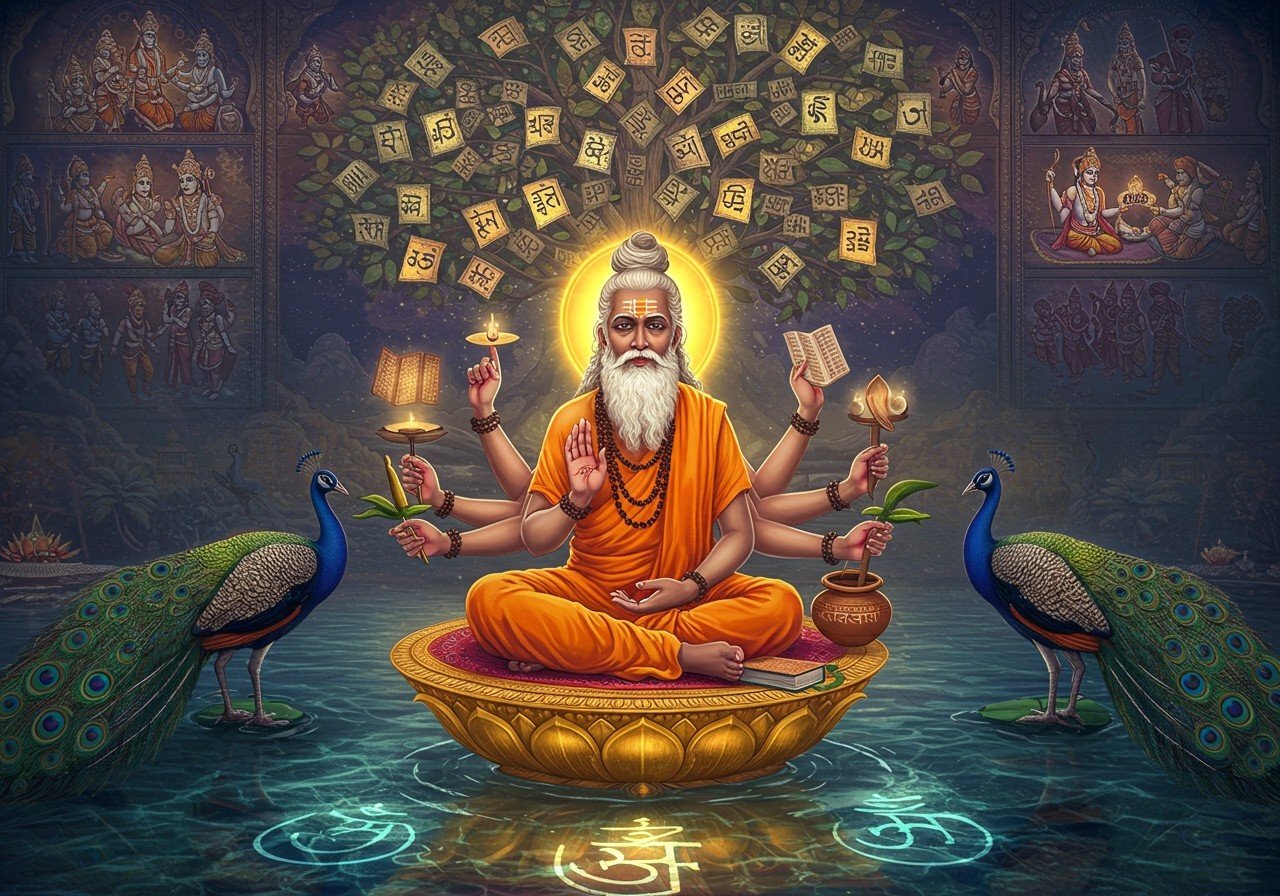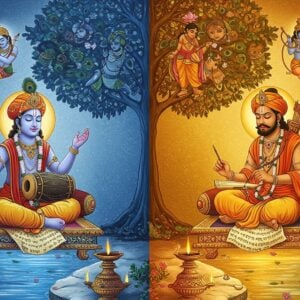
In Indian tradition, Veda Vyasa stands as a legendary figure, shaping cultural and spiritual landscapes. Known for composing the Mahabharata, his works have deeply influenced Indian culture, spirituality, and literature. As modern India balances tradition and contemporary life, Veda Vyasa’s teachings remain relevant. Delve into the life and works of this remarkable sage, exploring his birth, contributions, and enduring legacy.
Explore the Mahabharata and Ramayana: A Comparative Study
Who is Veda Vyasa?
Veda Vyasa, also called Krishna Dvaipayana, is a revered sage in Hindu tradition. He divided the Vedas into four parts—Rig, Sama, Yajur, and Atharva—making them more accessible. Vyasa is credited with writing the Mahabharata, which includes the Bhagavad Gita, a key text in Hindu philosophy. He also composed the 18 Puranas, ancient texts narrating the universe’s history. Vyasa is seen as a wise and compassionate figure who preserved Hindu dharma. His teachings continue through his disciples and lineage, like Shuka. Vyasa symbolizes a bridge between the divine and mortal realms, embodying wisdom and knowledge, influencing Indian culture where his teachings are still revered.
Veda Vyasa’s Birth
In the heart of India’s ancient stories, Veda Vyasa’s birth is extraordinary. Born to sage Parashara and Satyavati, a humble fisherwoman, Vyasa’s life began with a unique blend of wisdom and simplicity. On an island in the serene Yamuna River, his birth earned him the name ‘Dvaipayana,’ meaning ‘island-born.’ This name reflects the union of diverse backgrounds, showcasing how Vyasa’s life would bridge social divides. Vyasa’s birth carried a prophecy, foretelling his role in shaping India’s spiritual and literary realms. From an early age, Vyasa absorbed divine knowledge from his father, Parashara. This wisdom laid the foundation for his future contributions to Hindu philosophy and literature. His childhood, surrounded by legends and tales of innate wisdom, set the stage for his monumental works.
Veda Vyasa’s Death
The end of Vyasa’s earthly journey remains shrouded in mystery. Some traditions say he attained Samadhi, a profound state of meditation, in the tranquil Himalayas of Uttarakhand. Samadhi symbolizes spiritual liberation, transcending earthly existence. Legends whisper that Vyasa remains in eternal meditation, blessing and guiding the world from his sacred abode. Vyasa’s departure isn’t seen as a conventional death but a transition to a higher realm. His legacy continues through his disciples, ensuring his teachings endure. On Guru Purnima, a day dedicated to honoring spiritual teachers, Vyasa is revered for his wisdom. This celebration reflects the immortality of his knowledge, emphasizing the continuity of his teachings.
The Legacy of Veda Vyasa
Veda Vyasa’s contributions are woven into the fabric of Hindu literature and philosophy. The Mahabharata, a guide to dharma, profoundly influences Indian culture and values. Within it lies the Bhagavad Gita, offering timeless spiritual and ethical guidance. The 18 Puranas penned by Vyasa narrate mythological stories preserving cultural history and imparting moral lessons. His works resonate through Indian classical arts like dance, music, and theater, where his stories are vividly depicted. Modern media adaptations continue to bring Vyasa’s tales to new generations. His influence in television and cinema highlights his impact on popular culture. Vyasa stands as a symbol of wisdom and resilience, inspiring individuals to seek truth and enlightenment. In today’s world, where tradition and modernity coexist, Veda Vyasa’s teachings offer valuable insights into personal and collective well-being. His legacy endures, guiding seekers of knowledge and truth across generations.
How Poojn.in Supports Your Connection to Vedic Wisdom
At Poojn.in, we offer essential items to honor Sage Vyasa’s legacy and maintain Vedic traditions at home. Our curated collection includes:
- Complete Bhagavad Gita Sets: High-quality editions with Sanskrit texts and translations, ideal for daily reading and study. These sets often include commentaries to deepen understanding and are available in various bindings for durability and aesthetic appeal.
- Puja Items for Guru Purnima: Special items for worshipping Sage Vyasa, honored as the Adi Guru. This includes items like incense, flowers, and lamps, specifically chosen for their significance in traditional Guru Purnima observances.
- Pure Copper Kalash: Traditional vessels used in Vedic ceremonies and rituals. Copper is considered auspicious and is believed to enhance the positive energy of rituals.
- Brass Diyas: Sacred lamps for daily prayers and meditation, creating a serene and spiritual atmosphere.
- Authentic Dhoop and Agarbatti: Pure incense, creating a spiritual atmosphere during scripture reading. Various fragrances are available, each with traditional significance.
Srimad Bhagavad Gita (Bengali)
All Poojn.in products are sourced from trusted manufacturers following traditional methods, meeting strict quality standards for religious use. Our online platform provides convenient access to these sacred, authentic items. Visit www.poojn.in to explore our full range of Vedic worship supplies. We offer secure packaging and delivery across India, bringing authentic puja items to your doorstep.
Honoring Veda Vyasa Today
In our fast-paced lives, Veda Vyasa’s wisdom remains a guiding light. His teachings remind us of knowledge’s power and living with purpose and integrity. Celebrating festivals like Guru Purnima honors his contributions and reflects on his imparted values. With online shopping, accessing authentic ritual items for these celebrations is convenient. This blend of tradition and technology ensures Vyasa’s teachings enrich our lives. Keeping his stories alive connects us with our roots, cherishing his timeless values. Veda Vyasa’s legacy is more than his writings; it’s a living testament to truth, wisdom, and devotion. His timeless messages inspire us to seek harmony and understanding, weaving his teachings into our daily lives.
FAQs: Veda Vyasa: Life, Works, and Enduring Influence
Who is Veda Vyasa? Veda Vyasa, a revered sage in Hindu tradition, is credited with compiling the Vedas and writing the Mahabharata, a significant epic. His name, meaning “compiler,” reflects his role in organizing sacred texts.
When was Veda Vyasa born? He is believed to have been born on the full moon day of the Hindu month of Ashadha, celebrated as Guru Purnima.
What are Veda Vyasa’s key works? He compiled the four Vedas, authored the Mahabharata (including the Bhagavad Gita), and played a crucial role in composing the eighteen Puranas.
Explore the complexities of Ravana
What is the significance of Veda Vyasa’s work? His work is vital in preserving ancient India’s spiritual and philosophical knowledge, forming the foundation of Hindu culture and tradition.
How did Veda Vyasa influence Indian literature? His Mahabharata storytelling set a benchmark for epic narratives, inspiring writers and poets across generations.
What is the legend of Veda Vyasa’s birth? Divine myths surround his birth. Born to sage Parashara and Satyavati, he possessed extraordinary wisdom from birth.
How did Veda Vyasa die? Details of his death are unclear. Many believe he attained Samadhi, deep meditation, after fulfilling his earthly duties.
Poojn’s Tech Solutions: A Guide to Spiritual Growth


